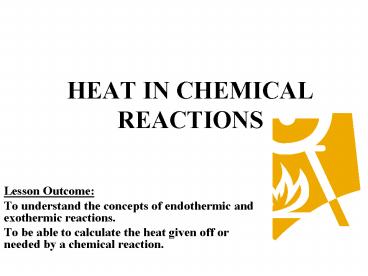HEAT IN CHEMICAL REACTIONS - PowerPoint PPT Presentation
1 / 11
Title:
HEAT IN CHEMICAL REACTIONS
Description:
HEAT IN CHEMICAL REACTIONS Lesson Outcome: To understand the concepts of endothermic and exothermic reactions. To be able to calculate the heat given off or needed by ... – PowerPoint PPT presentation
Number of Views:114
Avg rating:3.0/5.0
Title: HEAT IN CHEMICAL REACTIONS
1
HEAT IN CHEMICAL REACTIONS
- Lesson Outcome
- To understand the concepts of endothermic and
exothermic reactions. - To be able to calculate the heat given off or
needed by a chemical reaction.
2
Exothermic and Endothermic Reactions
- Joule The SI unit for energy and heat.
- Bond breaking vs. bond forming.
- Combustion is a process in which a
self-sustaining chemical reaction occurs at
temperatures above those of the surroundings.
3
EXOTHERMIC
- Exothermic reactions release heat.
- EXAMPLES
- direct combination reactions
- reactions of metals with water and acids
- reactions of acids with bases
4
ENDOTHERMIC
- Endothermic reactions absorb heat.
- EXAMPLES
- decomposition reaction
- some precipitation reactions
5
Enthalpy (H)
- ENTHALPY is a measure of the total energy
possessed by a substance or group of substances. - The change in enthalpy for a chemical reaction,
?H, is defined as the heat absorbed (per mole of
specified reactant or product) when the reaction
occurs at constant pressure.
?H enthalpy of products enthalpy of reactants
6
- Heat transfer and the sign of the enthalpy
change - When ?H is Positive
- Endothermic
- Heat absorbed
- Eg 95 KJ/mol
- When ?H is Negative
- Exothermic
- Heat released
- Eg 56KJ/mol
7
Enthalpy of Reactions ?Hrxn Hproducts -
Hreactants
- The enthalpy change (?H) for a reaction is equal
to the heat absorbed or gained during the
reaction. - The amount of heat absorbed / released is
dependent on the quantity (mole). - Standard enthalpy change (?Ho) at 1atm and 250C.
8
EXAMPLE OF ENTHALPY CALCULATIONS
9
EXAMPLE OF ENTHALPY CALCULATIONS
10
(No Transcript)
11
(No Transcript)































